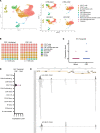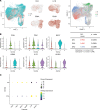HIV viral transcription and immune perturbations in the CNS of people with HIV despite ART
- PMID: 35801589
- PMCID: PMC9310520
- DOI: 10.1172/jci.insight.160267
HIV viral transcription and immune perturbations in the CNS of people with HIV despite ART
Abstract
People with HIV (PWH) on antiretroviral therapy (ART) experience elevated rates of neurological impairment, despite controlling for demographic factors and comorbidities, suggesting viral or neuroimmune etiologies for these deficits. Here, we apply multimodal and cross-compartmental single-cell analyses of paired cerebrospinal fluid (CSF) and peripheral blood in PWH and uninfected controls. We demonstrate that a subset of central memory CD4+ T cells in the CSF produced HIV-1 RNA, despite apparent systemic viral suppression, and that HIV-1-infected cells were more frequently found in the CSF than in the blood. Using cellular indexing of transcriptomes and epitopes by sequencing (CITE-seq), we show that the cell surface marker CD204 is a reliable marker for rare microglia-like cells in the CSF, which have been implicated in HIV neuropathogenesis, but which we did not find to contain HIV transcripts. Through a feature selection method for supervised deep learning of single-cell transcriptomes, we find that abnormal CD8+ T cell activation, rather than CD4+ T cell abnormalities, predominated in the CSF of PWH compared with controls. Overall, these findings suggest ongoing CNS viral persistence and compartmentalized CNS neuroimmune effects of HIV infection during ART and demonstrate the power of single-cell studies of CSF to better understand the CNS reservoir during HIV infection.
Keywords: AIDS/HIV; Neurological disorders; Neuroscience.
Conflict of interest statement
Figures





References
Publication types
MeSH terms
Grants and funding
- R21 MH118109/MH/NIMH NIH HHS/United States
- UM1 AI164559/AI/NIAID NIH HHS/United States
- R01 MH125737/MH/NIMH NIH HHS/United States
- R01 AG063846/AG/NIA NIH HHS/United States
- T32 AG019134/AG/NIA NIH HHS/United States
- R01 GM131642/GM/NIGMS NIH HHS/United States
- P30 AG021342/AG/NIA NIH HHS/United States
- K01 HL140271/HL/NHLBI NIH HHS/United States
- UL1 TR001863/TR/NCATS NIH HHS/United States
- R01 HL160392/HL/NHLBI NIH HHS/United States
- U01 DA053625/DA/NIDA NIH HHS/United States
- K23 MH118999/MH/NIMH NIH HHS/United States
LinkOut - more resources
Full Text Sources
Other Literature Sources
Medical
Molecular Biology Databases
Research Materials

